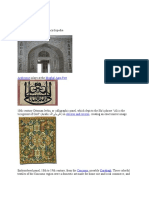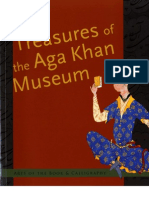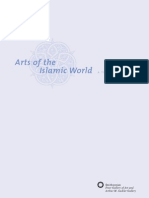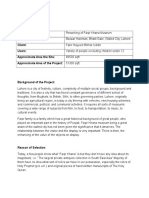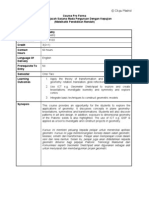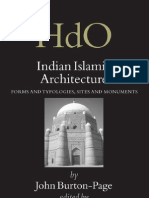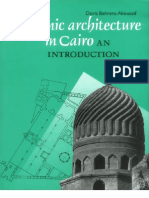Arabesque
Arabesque
Uploaded by
syarifah_arinaCopyright:
Available Formats
Arabesque
Arabesque
Uploaded by
syarifah_arinaOriginal Description:
Copyright
Available Formats
Share this document
Did you find this document useful?
Is this content inappropriate?
Copyright:
Available Formats
Arabesque
Arabesque
Uploaded by
syarifah_arinaCopyright:
Available Formats
ARABESQUE.
Arabesque simply means "in the Arab fashion" in French and few scholars of Islamic art use it until today. Arabesque is an element of Islamic art usually found for decoration on walls of the mosques, the arabesque is an elaborative application of repeating geometric forms that often echo from plants, shapes and sometimes animals. The choices and formation of these geometric forms are depending upon the Islamic view of the world where they also said that the patterns concretely symbolize the infinite, and therefore uncentralized nature of the creation of one od. !ostly Islamic arabesque artist always conveys spirituality without the iconography of the "hristian world.
HISTORY OF ARABESQUE #ntil today scholars still debating on the origins of arabesque pattern although it is clearly evident that much of the development and acceptance of this art were due to the !uslims. $i%e any other primitive arts, this primitive geometrical decoration was used in the early !esopotamia, &ersia, 'yria and also India where ,3th century arabesque, the ottoman the usage of the star patterns has anatolia been widely used by the "opts of (gypt. The early Islamic era adopted the semi naturalistic pre)Islamic motifs and patterns inspired from the barbarian nomads, *omans, followed by the diversity of ideas and e+perimentation according to the taste of the new !uslim generation. The highly abstract form was originated features the most original pattern generally %nown as the arabesque bac% in the early ,-th to ,.th century. Then followed by /apoleon0s framed e+pedition in the early ,1 th century, which contribute to the 2rientalism phenomenon in (urope.
4ac% to the ,5th century, first in Italy and then in the north was where the Islamic)style vegetal patterns were than developed. It was when the empires of the 2ttomans, 'afavids and the !ughals complicated versions of established their pattern were utilize which created the interest in naturalistic)loo%ing flowers or blossoms. 6ith it visual reference to the paradise, vegetal motifs and patterns in the Islamic art are largely being used and have their own symbolic meaning. 7owever, this geometric artwor% in the form of Arabesque was not widely used in the Islamic world but not until the golden age of Islam. At this time, ancient te+t were translated from the ree% and $atin into Arabic, where this were the times when many of great Islamic scholars were born in various fields li%e medicine, mathematics, geography, physics and many others. For an e+ample, the wor%s of &lato became popular at the time, which it was his ideas about the e+istence of a separate reality that was perfect in form, function and crystalline in character also contributed to the development of the Arabesque.
ITS SYMBOLIZATION The comple+ity and beauty of the Islamic geometric patterns always have the source of interest not only among !uslims but also other religions too. The Arabesques is a symbolic of their united faith and the way in which traditional Islamic cultures view the world which are, first, it recall the principles that govern the order of the worlds such as what ob8ects structurally sound. 'econdly, it is The wall decoration of Al)7ambra wall based upon the flowing nature of plant forms where it recalls the feminine nature if life giving.
!oreover, these geometric patterns create the aura of spirituality without abandoned the teaching of Islam. Thus, it
;etails on the wall of the hall of ambassador in Al) 7ambra,'pain.
shows the purity and orderliness of patterns and symmetries could create the sense of beauty and calmness where it will stimulate the intellect rather than trap in dreams and illusions.
TYPES OF ARABESQUE There are basically . types of Arabesque found in the Islamic art, which are9 ,. eometric interlacing wor%s or geometric patterns .. 'tylized plant forms or vegetal forms 1. GEOMETRIC PATTERNS. This was said the reasons why the Islamic world unites which is the factor of construction and meaning of Islamic geometric arabesque. This principle is seen in the clean and clear construction in the arabesques on various mosques and other Islamic buildings although they are in different countries, cultures and era. eometric patterns vary in their comple+ity and design, from a simple shapes to a very comple+ polygons and stars where they are constructed from the basic elements such as triangles, circles, squares, stars and polygons. Is was said that the theory of the Islamic geometrical patterns are based on the :square and he+agonal repeat unit and the root two and root three system of proportion0. For an e+ample a circle can be divide into four, or multiples of four, and other equal parts.
"2/'T*#"TI2/ 2F '7A&(' T7*2# 7 "I*"$(
"2/'T*#"TI2/ 2F T*IA/ $(
2.
"2/'T*#"TI2/ 2F '>#A*(
VEGETAL FORMS.
"2/'T*#"TI2/ 2F 7(=A 2/
These patterns are used along with the geometric patterns or as a filling for the comple+ geometric patterns. It consists of combination or individual forms of many leaves and plants especially the vine leaves, simply because they continuously growing and shows the concept of infinity. <egetal forms also are one of the ways to show and appreciate the beauty of Allah and 7is creation. #sually these forms are placed besides a contrasting bac%ground so that they will give an emphasis to the foreground. These %ind of forms are widely and commonly used in ceramics, woodwor%, even in carpets and te+tiles. In 2ttoman empire or the 2ttoman art usually use the large and feathery leaves called saz has been very popular and were used in drawings 8ust to show 8ust one or more leaves. 4esides the 2ttoman, the "hinese !uslims also used these vegetal forms on the porcelain, replaces the arabesque such as in pottery, te+tile and also miniature.
The iwan of Ta8 !ahal using the vegetal forms of arabesques
,?--0s pair of Islamic !amlu% *evival "andelstic%s
,5th century tile panel with vegetal forms of arabesques
An Izni% pottery plate with vegetal forms of leaves and flowers, Tur%ey.
You might also like
- Ghysels, Eric - Marcellino, Massimiliano - Applied Economic Forecasting Using Time Series Methods-Oxford University Press (2018)Document617 pagesGhysels, Eric - Marcellino, Massimiliano - Applied Economic Forecasting Using Time Series Methods-Oxford University Press (2018)scher1234No ratings yet
- Islamic Architecture 2Document24 pagesIslamic Architecture 2Siva Raman100% (5)
- Forestry DSGN Guidance FR PlyspDocument8 pagesForestry DSGN Guidance FR Plyspsyarifah_arinaNo ratings yet
- Islam and Visual ArtDocument8 pagesIslam and Visual Artpawan1979100% (1)
- Ustad Mansur and Flora and FaunaDocument18 pagesUstad Mansur and Flora and FaunaAnonymous ky08bk0No ratings yet
- Traditional Turkish ArtDocument200 pagesTraditional Turkish ArtMelisa Kalač Babačić100% (1)
- Carol Bier Curator Visions of InfinityDocument4 pagesCarol Bier Curator Visions of InfinityJacopo Shekari AlamdariNo ratings yet
- Islamic Art: Navigation SearchDocument26 pagesIslamic Art: Navigation Searchritika_dodejaNo ratings yet
- Elements in Islamic ArchitecureDocument25 pagesElements in Islamic ArchitecureZoondraNo ratings yet
- The History of Islamic Art and ArchitectureDocument11 pagesThe History of Islamic Art and ArchitectureAitzazMurtazaNo ratings yet
- Carol Bier Curator Falcons and Flowers SDocument6 pagesCarol Bier Curator Falcons and Flowers SJacopo Shekari AlamdariNo ratings yet
- Amin GulgeeDocument36 pagesAmin GulgeeRoohi Ahmed100% (1)
- Islamic ArtDocument44 pagesIslamic ArtNick25433% (3)
- South West and Central Asian Arts CharacteristicsDocument24 pagesSouth West and Central Asian Arts CharacteristicsSamantha Althea ArañaNo ratings yet
- Treasures of The Aga Khan MuseumDocument379 pagesTreasures of The Aga Khan Museumnordurljos100% (2)
- Islamic Arts and CultureDocument64 pagesIslamic Arts and Culturejoseph10022100% (20)
- Islamic ArchitectureDocument7 pagesIslamic Architectureapi-286657372No ratings yet
- Safavid PalacesDocument12 pagesSafavid PalacesmellacrousnofNo ratings yet
- Healing For What Is in The Breasts CeraDocument15 pagesHealing For What Is in The Breasts CeraConstantinoelgrandeNo ratings yet
- Architectural Representation of IslamDocument417 pagesArchitectural Representation of IslamMuhammad Abubakar AhmadNo ratings yet
- Muqarnas Vol 24Document317 pagesMuqarnas Vol 24alala babab100% (6)
- 01 Extract From Art of Islam by Titus Burkhardt PDFDocument7 pages01 Extract From Art of Islam by Titus Burkhardt PDFAmjad WaheedNo ratings yet
- Integrasi Sains PDFDocument240 pagesIntegrasi Sains PDFMokhammad YahyaNo ratings yet
- Arts of The Islamic WorldDocument91 pagesArts of The Islamic WorldRouf Ahmed Najar100% (16)
- Treasures of The Aga Khan MuseumDocument292 pagesTreasures of The Aga Khan MuseumFf SsNo ratings yet
- Slide 1-What Is Islamic ArchitectureDocument35 pagesSlide 1-What Is Islamic ArchitectureMuhammad SuhaimiNo ratings yet
- Evolution of Islamic and Their ArchitectureDocument43 pagesEvolution of Islamic and Their ArchitectureKaushik JayaveeranNo ratings yet
- Islamic GardensDocument18 pagesIslamic GardensArlene MartinoNo ratings yet
- How Does One Become An Oriental OrientalDocument13 pagesHow Does One Become An Oriental OrientalNehir TorunoğluNo ratings yet
- Art and Architecture in The Islamic TraditionDocument305 pagesArt and Architecture in The Islamic TraditionGustav Mahler100% (2)
- Mosques and Gateways: Mughal ArchitectureDocument31 pagesMosques and Gateways: Mughal ArchitectureKalpana PanditNo ratings yet
- Early Islamic Architecture PDFDocument111 pagesEarly Islamic Architecture PDFvtz2ruh100% (1)
- Islamic Architecture: Joy Alope and Nina Cabral Dfr1ADocument41 pagesIslamic Architecture: Joy Alope and Nina Cabral Dfr1ANatnael BahruNo ratings yet
- Mughal Miniature PaintingDocument31 pagesMughal Miniature PaintingShehryar KhattakNo ratings yet
- Islamic Tiles Web QuestDocument5 pagesIslamic Tiles Web Questعبد المعز عبد العزيزNo ratings yet
- Islamic Architecture: Members: Boribor, Angelica N. AR22FA1Document22 pagesIslamic Architecture: Members: Boribor, Angelica N. AR22FA1Angelica BoriborNo ratings yet
- Faqir Khana MuseumDocument4 pagesFaqir Khana MuseumWaqas AliNo ratings yet
- The Buildings of Early Islam by Leacroft Helen, Leacroft RichardDocument48 pagesThe Buildings of Early Islam by Leacroft Helen, Leacroft RichardFatuma SulymanNo ratings yet
- Islamic Architecture IntroductionDocument18 pagesIslamic Architecture IntroductionagustineleeNo ratings yet
- HOA - Early IslamicDocument29 pagesHOA - Early IslamicNeeraj VashistNo ratings yet
- Proforma Mte 3103 - GeometryDocument4 pagesProforma Mte 3103 - GeometryMUHAMMAD RIDHUAN BIN HANAFINo ratings yet
- 14 Ottoman MiniatureDocument36 pages14 Ottoman Miniatureourbook100% (1)
- Baradari of Wazir KhanDocument3 pagesBaradari of Wazir KhanMuhammadNazimNo ratings yet
- Architecture in Islamic ArtsDocument364 pagesArchitecture in Islamic ArtsSina Abedi100% (11)
- Islamic Architecture and ArchDocument9 pagesIslamic Architecture and ArchhemaliNo ratings yet
- Islamic ArchitectureDocument37 pagesIslamic ArchitectureUday DokrasNo ratings yet
- Islamic Art and Culture.Document234 pagesIslamic Art and Culture.nadia1362100% (1)
- Islamic ArchitectureDocument58 pagesIslamic Architecturesmarth kNo ratings yet
- Indian Islamic ArchitectureDocument283 pagesIndian Islamic ArchitectureBasha100% (9)
- Islamic Architecture in CairoDocument192 pagesIslamic Architecture in CairoMohamed Mansour100% (15)
- Islamic ArchitectureDocument50 pagesIslamic ArchitectureAlessandro Aste100% (1)
- 1-Introduction of Islamic Art:-: Arabesque:-DefinitionDocument6 pages1-Introduction of Islamic Art:-: Arabesque:-DefinitionSadia Mahmood100% (1)
- Islamic ArtDocument3 pagesIslamic Artyjyhm6cmqtNo ratings yet
- ArabesqueDocument3 pagesArabesqueLutfiMalikNo ratings yet
- What Is An ArabesqueDocument5 pagesWhat Is An ArabesqueHamza JouiniNo ratings yet
- Geometrical PatternsDocument14 pagesGeometrical PatternsErdoan Mustafov100% (1)
- Teachers' Resource - Maths and Islamic Art & DesignDocument8 pagesTeachers' Resource - Maths and Islamic Art & DesignjothivijayanNo ratings yet
- A Research On Islamic Geometric Patterns: by Serkan BaykusogluDocument35 pagesA Research On Islamic Geometric Patterns: by Serkan BaykusogluRuslan Adib100% (1)
- Arabesque PDFDocument27 pagesArabesque PDFSelma PandzicNo ratings yet
- UntitledDocument60 pagesUntitledZyrelle AtienzaNo ratings yet
- Nonfigural Design in Islamic ArtDocument3 pagesNonfigural Design in Islamic ArtImene bousaidNo ratings yet
- Greek Lecture NotesDocument133 pagesGreek Lecture Notessyarifah_arinaNo ratings yet
- TelecommunicationDocument8 pagesTelecommunicationsyarifah_arinaNo ratings yet
- Italian Renaissance ArchitectureDocument8 pagesItalian Renaissance Architecturesyarifah_arinaNo ratings yet
- Design For PlayDocument156 pagesDesign For Playsyarifah_arinaNo ratings yet
- Stadia PrinciplesDocument6 pagesStadia Principlessyarifah_arinaNo ratings yet
- 3A. Levelling: Rauf RasamDocument40 pages3A. Levelling: Rauf Rasamsyarifah_arinaNo ratings yet
- Tutorial Engineering SurveyDocument2 pagesTutorial Engineering Surveysyarifah_arinaNo ratings yet
- 7a TacheometryDocument19 pages7a Tacheometrysyarifah_arinaNo ratings yet
- Fluid Dynamics: Lecture Notes For MATH 6750Document43 pagesFluid Dynamics: Lecture Notes For MATH 6750Sathish PNo ratings yet
- MATH 5 DLL - Q1 - Multiplies A Fraction and A Whole Number and Another FractionDocument4 pagesMATH 5 DLL - Q1 - Multiplies A Fraction and A Whole Number and Another FractionMary Ann PontillasNo ratings yet
- Chapter2datarepresentationoncpupart1 140330042822 Phpapp01Document66 pagesChapter2datarepresentationoncpupart1 140330042822 Phpapp01Angel AlarasNo ratings yet
- Collins Edexcel Linear Homework Book Higher 2 AnswersDocument7 pagesCollins Edexcel Linear Homework Book Higher 2 Answersafnaiokculkyqc100% (1)
- Test 1 Spring 06Document11 pagesTest 1 Spring 06Gobara DhanNo ratings yet
- Data Analysis 2020Document56 pagesData Analysis 2020Jitlee PapaNo ratings yet
- Data Structures Using C, 2e Reema TharejaDocument25 pagesData Structures Using C, 2e Reema TharejaseravanakumarNo ratings yet
- BFC21103 Chapter2Document74 pagesBFC21103 Chapter2amirah100% (1)
- User Guide Incompact3d V1-0Document8 pagesUser Guide Incompact3d V1-0Danielle HaysNo ratings yet
- Dynamics of Machinery: Department of Mechanical EngineeringDocument19 pagesDynamics of Machinery: Department of Mechanical EngineeringEr Suraj HulkeNo ratings yet
- Mathematics 8 Quarter Iii - Activity 4Document3 pagesMathematics 8 Quarter Iii - Activity 4Henry ArenaNo ratings yet
- MFCC CodeDocument8 pagesMFCC Codesateesh83No ratings yet
- Resource Allocation: Class 7: 3/9/11Document64 pagesResource Allocation: Class 7: 3/9/11Tyas AgustinaNo ratings yet
- Undefined Terms CotDocument38 pagesUndefined Terms CotFunny Videos of all TimeNo ratings yet
- Ecc3012 Topic1 deDocument36 pagesEcc3012 Topic1 de周天乐No ratings yet
- How To Solve The Centroid of A TriangleDocument4 pagesHow To Solve The Centroid of A Trianglecircleteam123No ratings yet
- Math Comp - Junior IndDocument18 pagesMath Comp - Junior IndJames Sung Yoon WhangNo ratings yet
- T-Test: T-TEST GROUPS Kelompok (1 2) /missing Analysis /VARIABLES Post /CRITERIA CI (.95)Document2 pagesT-Test: T-TEST GROUPS Kelompok (1 2) /missing Analysis /VARIABLES Post /CRITERIA CI (.95)anisnurlailiNo ratings yet
- Lab 2 GisDocument5 pagesLab 2 GisMydady'sname ShakriNo ratings yet
- CFD Approach For Calibration of Nozzle MeterDocument4 pagesCFD Approach For Calibration of Nozzle MeterAshik GRNo ratings yet
- Ugc NetDocument88 pagesUgc NetPratap Kumar Sahu0% (1)
- L.O.s Math G12Document13 pagesL.O.s Math G12Mohammed AltiabNo ratings yet
- Public Debt and Inflation in Nigeria: An Econometric AnalysisDocument6 pagesPublic Debt and Inflation in Nigeria: An Econometric AnalysisDr. Ezeanyeji ClementNo ratings yet
- Module 02 Lesson 03 - Derivatives of Trigonometric Functions (With Limits)Document16 pagesModule 02 Lesson 03 - Derivatives of Trigonometric Functions (With Limits)Kiziahlyn Fiona BibayNo ratings yet
- Robo Guide BookDocument18 pagesRobo Guide BookVenkateswar Reddy MallepallyNo ratings yet
- Martell-Martell-The Effect of Friction in Pulleys On The Tension in Cables and Strings (2013)Document4 pagesMartell-Martell-The Effect of Friction in Pulleys On The Tension in Cables and Strings (2013)Junior ValenciaNo ratings yet
- Vector SpacesDocument16 pagesVector Spacesmarina_bobesiNo ratings yet
- Quiz2 s1 Spring21Document3 pagesQuiz2 s1 Spring21Zain AftabNo ratings yet
- Import Public Class Public Static Void New Int Int Int: Source CodeDocument7 pagesImport Public Class Public Static Void New Int Int Int: Source CodeRAHUL DASNo ratings yet







